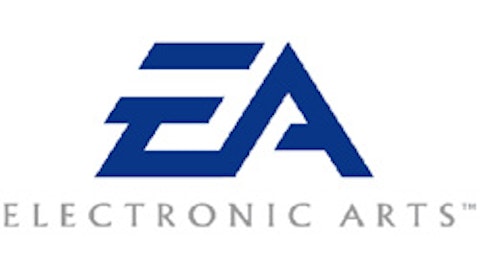Video game makers aim to captivate consumers across multiple platforms for longer periods of time, moving from packaged goods as a one-time delivery to digital games as an ongoing service. The industry expects a few benefits from this approach. Consumers will spend more money over the life of a game, especially through in-game micro-transactions and premium subscriptions, and digital services have lower costs and higher margins than traditional packaged goods.
Digital revenue
Electronic Arts Inc. (NASDAQ:EA) notes two major drivers of this shift to digital: PCs and wireless platforms. Electronic Arts Inc. (NASDAQ:EA)’s wireless, Internet-derived, and digital advertising net revenue before deferral has doubled in just two years, going from $833 million in fiscal 2011 to $1.227 billion in fiscal 2012 and to $1.663 billion in fiscal 2013. Unfortunately, digital revenue growth for fiscal 2014 does not continue at such an impressive rate; Electronic Arts Inc. (NASDAQ:EA) expects $1.7 billion in revenue from digital in the 2014 fiscal year, which is an impressive 42.5% of total revenue but only represents a 2.2% increase over fiscal 2013’s digital revenue. Digital revenue in fiscal 2013 was higher than usual because the company recognized $121 million of Battlefield 3 Premium subscription revenue in the fourth quarter, whereas a Battlefield 4 Premium subscription service, if announced, wouldn’t be recognized until the 2015 fiscal year. Even if we remove the $121 million from fiscal 2013’s digital revenue, we still see only a 10% year-over-year increase in digital revenue.
Similarly, Activision Blizzard, Inc. (NASDAQ:ATVI) is focusing on releasing frequent updates to its major franchises that encourage either an ongoing subscription or additional purchases from an in-game store. Improvements on this front led to 28% of the company’s revenues in the first quarter of 2013 coming from digital. The company will need to act quickly, as its iconic World of Warcraft franchise lost 1.3 million subscribers (or 14% of its user base) in the last quarter, with further declines expected. At an estimated $10 per subscriber per month, this could represent a loss of over $150 million in annual revenue.
A new console generation
Digital is becoming more important as packaged goods sales tend to fall this late in a console generation. Packaged goods sales throughout most of 2013 should be lower as customers postpone purchases of current-generation games and consoles in expectation of the release of the next generation consoles in fall 2013. Sales in the last couple months of 2013 should be stronger than previous periods since a greater percentage of PS4 and Xbox One owners will likely purchase games early in the new console cycle.
One example of what not to do is Take-Two Interactive Software, Inc. (NASDAQ:TTWO)‘s planned release of GTA V in September 2013 for the PS3 and Xbox 360, but not for the next generation of consoles. I expect that GTA V’s sales will be significantly lower than they would have been if the game had been released a year ago — in the face of the new consoles, consumers are simply tired of the PS3 and Xbox 360.
The mobile market
What will drive video game makers’ online, direct download and wireless business over the next few years? One challenge with developing mobile apps is that the barriers to entry are significantly reduced compared to console games, in part because the games are not as complex and the graphics requirements are not as high. An example of the potential success of Electronic Arts Inc. (NASDAQ:EA)’s strategy is The Simpsons: Tapped Out, which earned $50 million in sales from its launch in August 2012 to March 2013, with March accounting for $10 million of that total. One concern is that $50 million in sales over 6 months is not large enough to make a meaningful impact on the performance of a multi-billion dollar company. It’s unlikely that this game has the staying power to ramp to hundreds of millions of dollars of revenue.
EA’s competitors complete the spectrum of approaches in response to mobile gaming and so-called “freemium” models. Showing a sense of urgency, Take-Two Interactive Software, Inc. (NASDAQ:TTWO) has released four mobile titles in under two months: Haunted Hollow, Sid Meier’s Ace Patrol, Beejumbled, and XCOM: Enemy Unknown. The first 3 are free-to-play, while the latter retails for $19.99. The company now offers ten games for iOS and five for Android. EA’s games have been in the marketplace longer, however, so it’s no surprise that many of Electronic Arts Inc. (NASDAQ:EA)’s mobile games have more than one million installs, while not one of Take-Two Interactive Software, Inc. (NASDAQ:TTWO)’s mobile games has more than 100,000 installs and most have fewer than 10,000 installs.
Activision Blizzard, Inc. (NASDAQ:ATVI) is watching the mobile gaming market carefully, but so far has elected not to invest any money in creating games for this space until it is confident that it will earn a decent return. In its latest quarterly earnings call, the company noted that the top ten mobile franchises have changed every year for the past five years, with no history of generating significant sustainable operating income. The company views mobile as a market with long-term potential but significant short-term risks.
Conclusion
I am pleased to see a credible vision from Electronic Arts Inc. (NASDAQ:EA) in regard to broadening the company’s intellectual property brands to engage consumers across multiple platforms including digital distribution, consoles and mobile. This vision includes both the initial purchase and in-game micro-transactions or monthly subscriptions that turn games from a one-time purchase to an ongoing experience that continues nearly a year after the game’s launch. Now is the time to execute, but given the past year’s difficulties with the FIFA 13, SimCity, and Medal of Honor Warfighter releases, execution has never been Electronic Arts Inc. (NASDAQ:EA)’s strong suit.
The market has priced in superior execution from Activision Blizzard, Inc. (NASDAQ:ATVI), as shown by the company’s higher price-to-revenue multiple. Activision Blizzard, Inc. (NASDAQ:ATVI) had revenue over the past twelve months of $5 billion and is currently valued around $15 billion, a multiple of 3. EA posted trailing twelve month (TTM) revenue of $3.8 billion and sports a market cap of $6.7 billion (a multiple of 1.76), while Take-Two Interactive has the smallest multiple at 1.08 its TTM revenue for a market cap of $1.3 billion. Take-Two Interactive’s stock has the greatest room to run given its low valuation, while reversion to the mean could spell short-term headwinds for Activision Blizzard, Inc. (NASDAQ:ATVI).
To the extent that the above companies can earn a larger percentage of more profitable digital revenues compared to traditional packaged goods, they all have potential to increase the revenue-per-customer generated over the life of each game. As a result, they may legitimately warrant a multiple higher than the industry average.
The article Which Video Game Maker Will Win Digital? originally appeared on Fool.com and is written by Jason Earley.
Jason Earley has no position in any stocks mentioned. The Motley Fool recommends Activision Blizzard and Take-Two Interactive . The Motley Fool owns shares of Activision Blizzard. Jason is a member of The Motley Fool Blog Network — entries represent the personal opinion of the blogger and are not formally edited.
Copyright © 1995 – 2013 The Motley Fool, LLC. All rights reserved. The Motley Fool has a disclosure policy.





